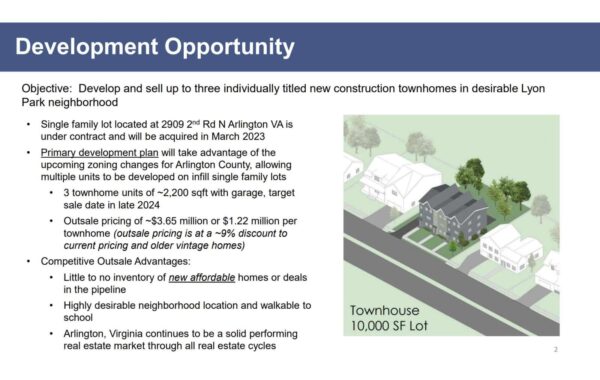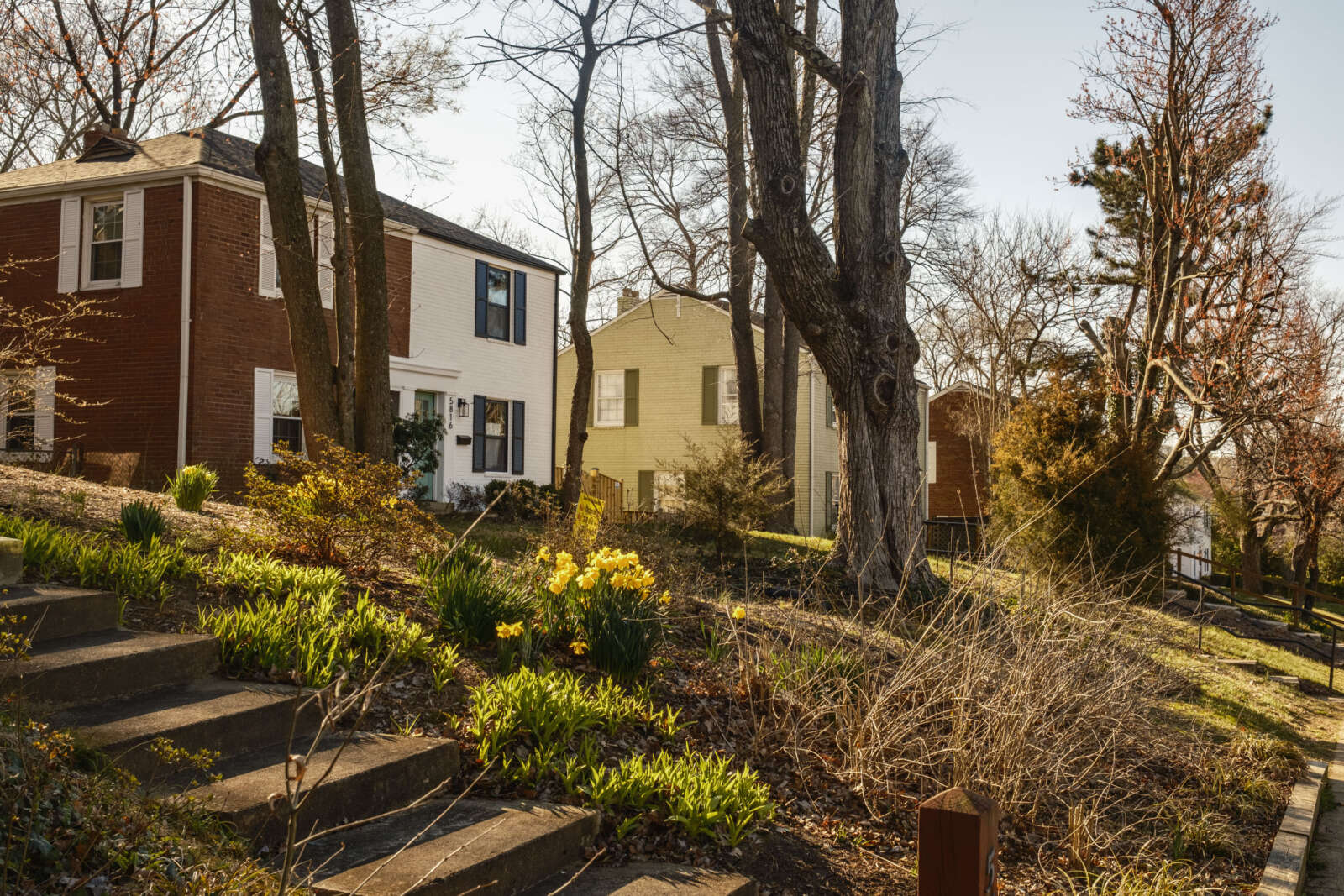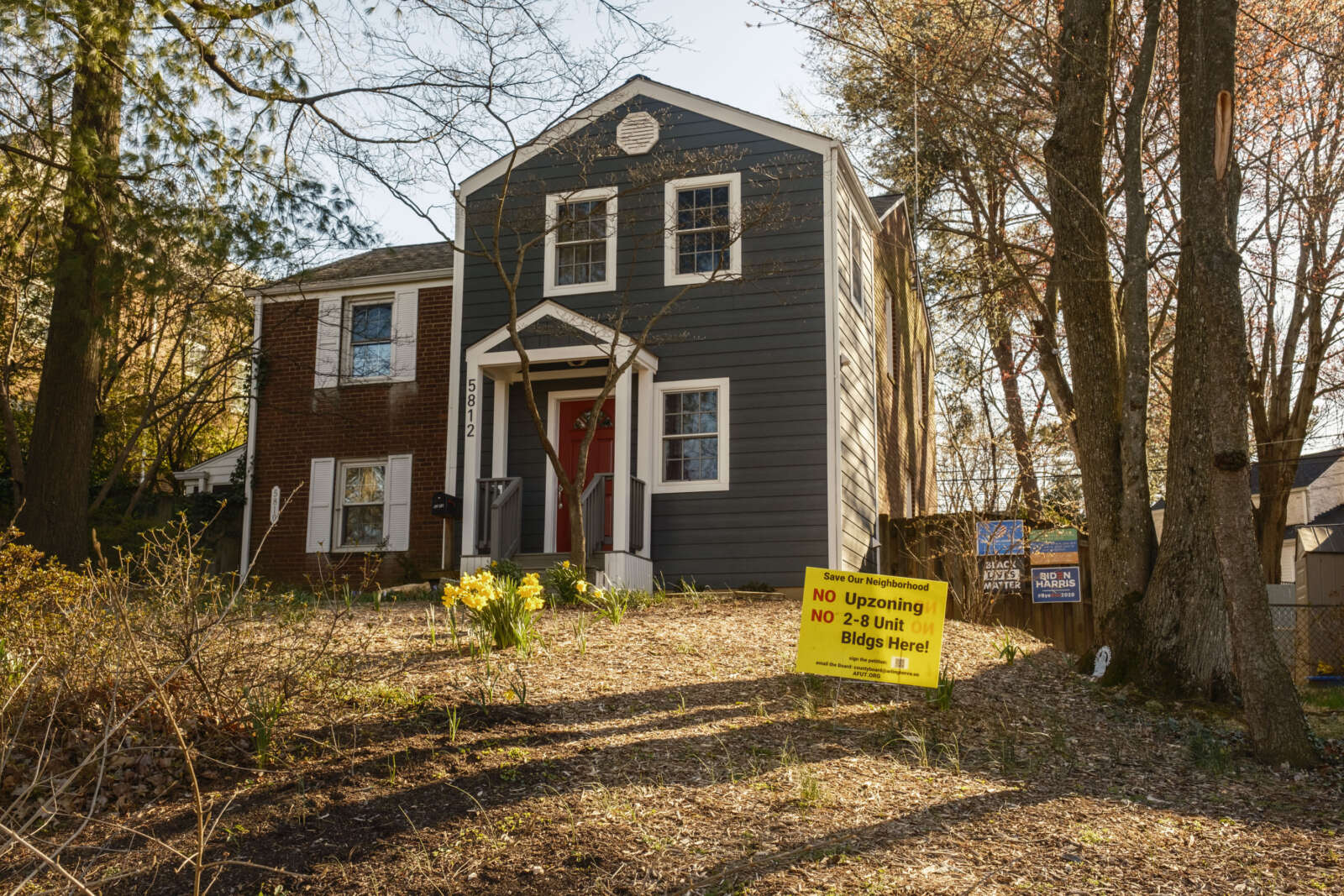The following in-depth local reporting was supported by the ARLnow Press Club. Join today to support local journalism and to get an early look at what we’re planning to cover each day.
Last week, the Arlington County Board voted unanimously to allow homeowners, builders and developers to convert or build new 2-6 unit homes throughout the county.
Those changes will not go into effect until July 1 and it will be even longer before such buildings actually spring up.
“Nothing will be built a year from now. It may be permitted, but it won’t be built,” Arlington County Board Chair Christian Dorsey predicted to ARLnow after the vote last Wednesday. “We’re really going to have to wait, I think, 18 months before we actually have anything we can sink our teeth into.”
Dorsey seemed confident that county staff have sufficient direction to prepare for the first “Missing Middle” housing applications.
“[Staff] are already going to work on ‘What are we going to do with permitting? What are we doing to set up a structure?’ but then, also, ‘What are the technical, advisory resources that we’re going to make available to allow people to navigate through it?'” he said.
For staff and for builders, the county is entering uncharted waters.
“It’s really new,” Dorsey said. “The existing duplexes, triplexes and townhouses are fairly matured in this county, but the other forms, we haven’t really seen them in recent history,” he said.
While it will be at least a year and a half before there is anything to see, behind the scenes, activity is already humming.
County staff are working on educational materials and getting Permit Arlington, the county’s online permitting system, ready. A few local developers have put out feelers regarding where to build townhomes. County Board members are already directing planning staff to study other aspects of the zoning code to see how standards can be strengthened to prevent tree canopy loss.
Staff gets to work
The next three months will be busy for county staff.
Staff will put out educational materials for property owners and building industry professionals explaining possibilities and requirements.
County planners will study up for meetings with people who want to build EHO units — Arlington’s term of art for what it just allowed is “Expanded Housing Options” — which are being encouraging so people can go over code requirements and their applications with staff before submitting them. Lastly, they will add a zoning permit application for EHO development to Permit Arlington.
ARLnow recently reported on issues with the online permitting system. Builders and architects blame these issues, along with the need for pre-construction meetings, for construction delays and more expensive projects. They tell us that the staffing level dedicated to reviewing applications will determine how successful Arlington is in encouraging EHO construction.
“Having a consistent plan review process would be the most helpful way that the county could support this new type of initiative,” David Tracy, the president of local home-building company Classic Cottages, tells ARLnow. “The permitting piece in Arlington is rigorous already [for single-family detached homes]. This is supposed to go through more or less the same process and that is a months-long process.”
What will be built and where?
While 2-6 unit buildings are broadly allowed in all districts previously zoned only for single-family detached dwellings, some lots will be too small for certain kinds of projects and others are ineligible because the county says they could be assembled with other properties for bigger development projects.
A cap of 58 approved projects per year for five years, distributed geographically, will to some degree dictate where these buildings go.
Some in the home-design and building industry predict that despite the nearly blanket allowance, EHO homes will likely be concentrated around walkable amenities.
“My own personal view is that there need to be walkable amenities around in order for people to want to live in this type of house,” Tracy said. “If there’s a condo building in the western part of the county where the zoning is R-10 and R-20, the head-scratcher is why would you buy a condo or townhome, which I associate… with a more urban existence.”
Tracy said the cap has benefit and trade-offs. It might help regulate the review process but it could create a “false scarcity” that dissuades people from undertaking EHO projects.
“The worst thing you can do for a builder is create uncertainty,” he said, adding that they cannot afford to wait a year if the cap is hit and their project misses the boat. “You’re going to distort the market.”
County Board member Katie Cristol tried to make that point during the rezoning approval, arguing that uncertainty will keep Missing Middle units from being built, but her motion to double the cap was voted down.
County Board Vice-Chair Libby Garvey told supporters in an email this week that she pushed for these two measures.
“I have consistently worked to make these changes more of a pilot than sweeping changes,” said Garvey, who for a while led the charge against the never-built Columbia Pike streetcar. “While the final adoption is not quite as limited or as dispersed as I would like, I think it will allow us to see how this works out over time and over different portions of the County.”
Architect Ethan Marsh expects Missing Middle-type homes will pop up near transit, such as in Lyon Village and Lyon Park, which flank the Clarendon and Courthouse neighborhoods along the Orange and Silver lines.
But the building might extend to neighborhoods a bit further afield from transit, like Marsh’s former neighborhood of Penrose.
“In those areas, you can walk to Columbia Pike and catch a bus, which I did often, or get to Clarendon on a scooter,” he said. “Those areas lend themselves better to Missing Middle because you can increase density without increasing parking, because you have walkability… This area sort of markets itself.”
It seemingly already has. In a conversation in a local neighborhood email listserv, shared with ARLnow, someone who owns a property in Lyon Village explained how he would make more money replacing his $1.2 million house with a 3-unit townhouse, with each unit listed around $1.5 million, over one large, $2.7 million single-family home. Citing concerns of overcrowding in the neighborhood school his kids attend, the individual said he would not build a 6-plex.
Meanwhile, a speculative development brochure shared with ARLnow seeks investors for a similar development planned for a single-family colonial home, built in 1947, in Lyon Park.
The home, described as “in disrepair” and on an “under-utilized” site, was sold for around $950,000 this February to a registered LLC named for the home’s address, according to county property records. The investment pitch proposes envisions building three townhouses, which would sell for just over $1.22 million each, which would still be less expensive than many older single-family homes in the area.

Over the last couple of years, people have debated how attainable these units would be, particularly to people making less than $100,000 per year. ARLnow asked a few local nonprofit affordable housing providers if they would be building Missing Middle-type homes to provide homeownership opportunities to lower-income residents.
Two said they would not be, but they support the changes because of how they will expand housing. The local Habitat for Humanity chapter, however, indicated interest.
“This change opens up large portions of the County where we were effectively priced out before, and we will be working hard to make the new policy a successful reality,” Director of Donor Engagement & Communications Liz Salter told ARLnow.
She said Habitat has “considerable experience” building stacked flats, two-over-twos and smaller multifamily structures in D.C. for homeownership units.
“And we have successfully built 3+ bedroom units within the smaller envelopes that would be characteristic of an [EHO] multiplex,” she said.
Planning for growth
Missing Middle critics often predicted overcrowding at schools, some of which already have not-so-temporary trailers offsetting enrollment increases.
For the part of Arlington Public Schools, it says the rezoning adoption will have impacts small enough not to significantly affect enrollment planning in the near term. APS believes Missing Middle will add roughly nine to 13 students per year, spread across elementary, middle and high schools.
“The Missing Middle housing growth should be similar to what to the growth in accessory dwellings, which were approved in 2017,” APS spokesman Frank Bellavia says, noting that 99 parcels across Arlington have ADUs.
He did say that the annual cap on projects would be beneficial.
“The caps established for the first five years of the MM makes it more manageable for APS to absorb any increase in new students,” he said. “APS closely collaborates with Arlington County staff on projections and any changes to the pace of development will be on our radar.”
Addressing overcrowding, Bellavia said APS has a few planning processes through which it can address growth by expanding existing schools, repurposing current space or collaborating with the county on other types of expansions.
“The most recent APS Capital Improvement Plan and bond is investing in a new facility that will expand the number of students served by the Arlington Career Center,” he said. “The next CIP will also include a schedule and funds to begin renovating and modernizing existing APS facilities. We believe that the combined initiatives will help absorb any increases in enrollment due to Missing Middle.”
Meanwhile, those who like crunching numbers can eventually expect a lot of data tracking growth related to Missing Middle.
Permit applications and approvals will be published in real-time and likely added to interactive map promoted through newsletters. Annual reports will include data on:
- EHO types, unit numbers and locations
- New construction vs. renovations
- Owner and renter-occupation rates
- Lot size and coverage and impervious surface coverage
- Tree planting and retention
- Parking spaces provided per unit
- Number and location of requested and approved parking reductions
- Demographics of residents living in EHO development, if possible
- APS student generation
In the cases where new EHO construction replaces a dwelling, for interest, the county is also interested in tracking whether the owner or renters live inside.
The data would provide a clearer picture of whether predictions from critics are coming to pass, including one that the changes will yield more 1-2 bedroom rentals than family-sized, 3-4 bedroom units for sale.
The future of McMansions
The foil to EHO development has long been the so-called McMansion, a pejorative for new single-family homes derided by critics as oversized, cookie cutter and cheaply built.
Some proponents have reasoned that if the zoning code can allow for these buildings housing one family, it should allow structures with the same footprint to house multiple families. Now, the question is whether large single-family homes might see additional county scrutiny.
The Arlington County Board has encouraged staff to prioritize studying lot coverage and building placement standards to find ways to preserve trees from being cut down. The new zoning code requires between four and eight trees per unit on properties developed with EHOs.
Members and Planning Commissioners are also interested in adding to the zoning code a standard for floor area ratio, or the ratio of a building’s base to the size of the lot it is built on.
“We’re hearing a lot about this, I’d love to move it forward faster,” Garvey said during a budget work session with the Department of Community Planning, Housing and Development.
Planning Director Anthony Fusarelli responded that staff may be overextended and that work could not begin until other studies wrapped up in 2024.
Cristol recommended implementing “quick-strike” rule changes for lot coverage that could come out of an update to Arlington’s Forestry and Natural Resources Plan, a final draft of which is expected to be ready this spring or summer.
This will, she said, “really serve this strongly held desire to protect trees in development of low-density properties.”
She warned that without determining community priorities for lot coverage, the county could end up in another contentious policy debate.
“I’m very eager to take up this conversation and I think there are a lot of interesting ideas,” she said. “I hope we can find a little capacity to pursue that goal overall.”



